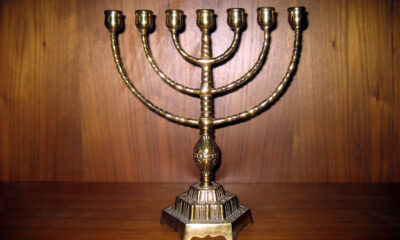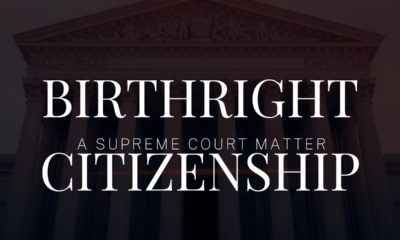Constitution
Mary Peltola flips Alaska House seat
Mary Peltola came out the winner for Alaska’s At-large House seat, because Republican voters don’t know how Ranked Choice Voting works.
The results of Alaska’s first ranked choice voting election have come in. Mary Peltola, the Democrat, now goes to Washington as Alaska’s At-large Representative. The final tally tells the tale of how this happened – and those results say much more about how Alaska politics differs greatly from the politics of the contiguous United States. It also means that Donald Trump has a few lessons to learn if he hopes to capture Alaska.
How Mary Peltola won
For reportage, CNAV has chosen the Anchorage Daily News and Alaska’s own Division of Elections. Anchorage is Alaska’s largest city with races competitive between Republicans and Democrats.
On August 16, Alaska held Top Four primaries and also a Special General Election with ranked choice voting. Decision Desk Headquarters had the results, including Round One of that special election:
Candidate Votes Pct. Mary Peltola DEM 58,689 38.61% Sarah Palin GOP 49,262 32.41% Nick Begich GOP 44,065 28.99%
Votes in: Estimated 85% Votes counted: 152,016
Mary Peltola started with an advantage. But if Nick Begich’s voters had all ranked Sarah Palin second, she would have won. As the Anchorage Daily News reported overnight (actually, on Wednesday afternoon Alaska time), this did not happen.
Detailed results
The Alaska Division of Elections has the results from Rounds One and Two, showing what did happen.
Round 1
Candidate Votes Percentage Begich, Nick 53,756 28.52% Palin, Sarah 58,945 31.28% Peltola, Mary S. 75,761 40.20% Continuing Ballots Total 188,462 Blanks 3,401 Exhausted 0 Overvotes 295 Remainder Points 0 Non Transferable Total 3,696
Begich, Nick is eliminated because the candidate had the least amount of votes.
Elimination transfer for candidate Begich, Nick.
53756 ballots have been transferred in the following manner:
| Transferred from | Transferred to | Ballots | Votes |
| Begich, Nick | Palin, Sarah | 27042 | 27,042 |
| Begich, Nick | Peltola, Mary S. | 15445 | 15,445 |
| Begich, Nick | Exhausted | 11222 | 11,222 |
| Begich, Nick | Overvotes | 47 | 47 |
Round 2
Candidate Votes Percentage Begich, Nick 0 0.00% Palin, Sarah 85,987 48.53% Peltola, Mary S. 91,206 51.47% Continuing Ballots Total 177,193 Blanks 3,401 Exhausted 11,222 Overvotes 342 Remainder Points 0 Non Transferable Total 14,965
Palin, Sarah is eliminated because the candidate was not elected in the last round.
Peltola, Mary S. is elected because all other candidates have been eliminated.
CNAV has defined ranked choice voting before. But now a few more terms beg definition:
Ballot exhaustion occurs when a voter has not ranked all possible choices, and all the choices he did rank, are out of the race.
Overvoting happens when someone votes for more choices than the rules allow. In ranked choice voting, voting for more than one first choice counts as an overvote. Such a ballot does not count.
What did Nick Begich’s supporters do?
First, notice that 3,401 voters did not even vote in that special election, hence the “blanks” in the tables. Notice also that 295 people “overvoted” in the first round. For whom did they vote? We don’t know, and it doesn’t matter. When a voter overvotes, election officials “spoil” the ballot.
Obviously Nick Begich fell out of the race in the first round. So the Division of Elections had to read the second choices of his voters. And what do we see?
27,042 people listed Sarah Palin as their second choice. But another 15,445 voters listed Mary Peltola as their second choice. Why would they do that? Because remember: the Begiches are Democrats, or were before Nick decided to run as a Republican. Many of his voters could not stand Palin, or else were afraid of her reputation. So they voted for Mary Peltola instead.
Another 11,222 voters marked a first choice only. Now that Nick Begich was out of the race, they had exhausted their votes. Now maybe those voters genuinely did not care who won if Nick Begich didn’t. But more likely those voters did not know how to vote a ranked choice ballot.
The overvote tally rose to 342, which suggests another 47 people voted for two second choices.
Therefore Mary Peltola got the votes of 75,761 people who really wanted her, plus another 15,445 who couldn’t stand Sarah Palin. Worse, Sarah Palin lost 11,222 votes because voters didn’t know how ranked choice voting works.
Who is Mary Peltola?
Mary Peltola is half Alaskan Native. The other “half” is Down South, which is to say a Nebraska man who moved to Alaska to teach school. He married a Yup’ik woman and then became a bush pilot. (Note: “Down South,” “Lower Forty-eight,” and “Outsider” are Alaskan names for the contiguous United States.) Other than that, Mary Peltola is a complete unknown. She will fill in her ideological blanks over the next two months.
The Peltolas and the Palins have a long history of friendship, and Sarah Palin showed no signs of breaking it, win or lose. The Begiches are another story: they are Democrats, and Nick is the first Begich to run “as a Republican.”
Moving forward, Mary Peltola will enter the House of Representatives at once. But all three, together with Republican Tara Sweeney, will run in another race at Midterms. That race will determine who serves a term in the House beginning in January 2023.
Sarah Palin called on Nick Begich to get out of the Midterms race now. But she also said that ranked choice voting “disenfranchised” too many Alaskans. Then she said this:
We can’t be disheartened, in fact, I think God prepared me for an outcome like this, believe it or not. I think God has kind of given me peace all along. No matter what the outcome was, we’re running to expose the strange things going on in our politics that are harming our nation and our state.
Why Mary Peltola and not Sarah Palin?
The Anchorage Daily News’ Iris Samuels attended Sarah Palin’s election watch party. As she reported:
There was initial confusion at what the numbers meant, followed by disbelief and then anger. “How is that possible?” one campaign volunteer shouted when it became clear that Palin would lose.
How is that possible? Simple. Ranked choice voting exchanges one kind of election spoiling for another. Exit the candidate who draws enough votes from someone who should finish first, so that another candidate finishes first, instead. (Like the three boni candidates for Pontifex Maximus in 63 BC, who split their votes, allowing Julius Caesar to win.) Enter the candidate with a significant number of followers who, in the second choice, vote for a finisher in the other Party just to spite the other candidate of the same Party. Which is what moved those 15,445 voters to vote as they did.
The “disenfranchisement” to which Sarah Palin refers, results from the exhaustion of 11,222 ballots because voters did not know how to vote in a ranked choice election.
Moving forward
First, the Sarah Palin campaign needs to teach people how to do ranked choice voting properly. If half the Begich voters who “exhausted” their ballots had ranked Sarah Palin as second choice instead, Sarah Palin would be going to Congress instead of Mary Peltola. So the first place to start is to teach the best way to mark a ranked choice ballot. Which is to be sure to mark down a ranking for every candidate on the ballot. To leave any candidate unranked, but especially to leave two candidates unranked, is to risk exhaustion. 11,222 voters made that mistake.
Second, Sarah Palin needs to come to grips with the horrible reputation that a bunch of Down South people have given her. Perhaps she also has to come to grips with a Down South man friendly to her, who himself has a nasty reputation in Alaska. As a result of both, she lost 15,445 votes because voters, voting for a nominal Republican as first choice, voted for the Democrat as second choice.
Could that happen Down South? Maybe not so readily, because Alaska politics allows for cross-Party friendships as no other State does. But it could. The exhaustion and overvoting certainly could. CNAV has seen such things affect a Party canvass in Virginia.
Third, Sarah Palin must set out to convert “The Bush” from Democrat to Republican. Mary Peltola is a product of “The Bush.” The same holds for Juneau and other Big Cities with Down South Big City habits.
Leave a comment
Kelly Tshibaka has an even worse challenge in the Senate race. Lisa Murkowski comes from the Murkowskis, a notorious RINO family. And not only did she finish the primary ahead of Kelly Tshibaka, but she would benefit from Pat Chesbro’s votes. Pat Chesbro, the Democrat, finished third in the Top Four primary, not fourth. As of this writing, the Elections Division has not awarded the fourth place in the Senate primary. Whoever wins it could pad Lisa Murkowski’s numbers, though not enough to win outright. But Pat Chesbro’s numbers would definitely put Lisa Murkowski over the simple majority threshold.
For that reason, Kelly Tshibaka cannot rest until she peels off enough of Lisa Murkowski’s voters to win outright in the first round. So it comes down to how badly she wants to win, and how badly Donald Trump wants her to win. And the lesson of how Mary Peltola beat Sarah Palin also applies to this Senate race. Notice that the Anchorage Daily News didn’t give the instructive details on how Palin lost the exhausted and “spite” vote. Kelly Tshibaka must not let either thing happen to her.
CNAV invites comments always, but especially this time, and from anyone who lives in Alaska. Your editor admittedly hails from Down South, and has no “Anchorage Bureau Chief.” (If this sounds like a call for volunteers, it is.) So if your editor has missed something, as he probably has, leave a comment.
Terry A. Hurlbut has been a student of politics, philosophy, and science for more than 35 years. He is a graduate of Yale College and has served as a physician-level laboratory administrator in a 250-bed community hospital. He also is a serious student of the Bible, is conversant in its two primary original languages, and has followed the creation-science movement closely since 1993.
-

 Civilization4 days ago
Civilization4 days agoDC Pipe Bomb Arrest Raises Questions About Christopher’s Wray’s FBI
-

 Civilization5 days ago
Civilization5 days agoThe Legal Logic Behind U.S. Operations Against Narco-Terrorist Networks
-

 Executive5 days ago
Executive5 days agoNewsom’s ‘National Model’ for Homeless Wracked by Fraud
-

 Executive2 days ago
Executive2 days agoWaste of the Day: Obamacare Failed Test, Approved Fraudulent Subsidies
-

 Executive4 days ago
Executive4 days agoWhen You’re in a Hole, Stop Digging
-

 Education3 days ago
Education3 days agoWaste of the Day: Taxpayers Subsidize Football Coach Severance
-

 Civilization3 days ago
Civilization3 days agoPence Calls on Trump To Fire RFK Jr Over Abortion Drug
-

 Civilization3 days ago
Civilization3 days agoRight-Wing Antisemitism, Liberalism, and Leo Strauss










